|
The Family of Wilbur Leicht
151st Signal Company
2007 European Tour

TOAL Journal
Trip of a Lifetime
(Click on photos to enlarge)
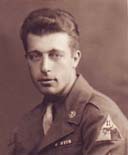
Wilbur Leicht
Well, we pulled it off. After months of planning and help from lots of people in this country and several others, we accomplished the mission – we returned Dad to Europe to retrace his steps of 1944 & 45, and in doing so, honored he and his unit for their part in ending the horror of World War II.
Some credits first; Maj Gen (Ret) Ken Bowra, US Army; Lieut Laurent MacGuffie, French Army; 11th AD veteran and Division rep Vince Mahler; US Defense Attaché in Austria Colonel Stefan Aubrey; and Mrs Sieglindi Witzany - all of whom were instrumental in helping us create and execute what we came to call the Trip Of A Lifetime
(TOAL).
 The Crew was three generations of the Leichts and two other family members; 151st Signal Company/11th AD veteran Bill Leicht; sons Bob, Bill, and Steve Leicht; grandson Rob Leicht; Son-in-Law Russ Fenton; and Russ’s Son-in-Law Tony Caito. We departed Newark, NJ at 6:30 p.m. on Thursday, 30 August and had an uneventful overnight flight, arriving on Friday, 31 August at Charles DeGaulle airport at 7:30 a.m. The airport experience was interesting, but we got our bags and were waved thru customs to exit to the terminal area, where Rob was waiting as planned (he’s an Army Captain stationed in Germany). The Crew was three generations of the Leichts and two other family members; 151st Signal Company/11th AD veteran Bill Leicht; sons Bob, Bill, and Steve Leicht; grandson Rob Leicht; Son-in-Law Russ Fenton; and Russ’s Son-in-Law Tony Caito. We departed Newark, NJ at 6:30 p.m. on Thursday, 30 August and had an uneventful overnight flight, arriving on Friday, 31 August at Charles DeGaulle airport at 7:30 a.m. The airport experience was interesting, but we got our bags and were waved thru customs to exit to the terminal area, where Rob was waiting as planned (he’s an Army Captain stationed in Germany).
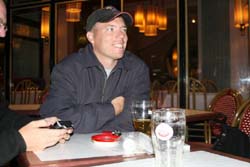 So we started what would be two very nice days in Paris. Rob did most of the driving in a large van, using his driving skills and GPS which didn’t fail us once.
Good man, that Robert Charles, although we did learn he is seriously ticklish. So we started what would be two very nice days in Paris. Rob did most of the driving in a large van, using his driving skills and GPS which didn’t fail us once.
Good man, that Robert Charles, although we did learn he is seriously ticklish.
We checked in to the French military’s hotel, which was about a 20 minute walk north of the Seine. At this point the Crew broke up, with some napping and others heading out to see the sights. We came together both days (31st and Sept 1) to eat or tour together, but we all did the Eifel Tower, Champs Elysees, Louvre, and the Arc de Triumph.
 The Eifel Tower is amazing, not least of which for the fact that it was built as a temporary attraction for a World Exposition back in 1889 or so. There was lots of opposition to it as a blight on the skyline, etc, but wiser heads prevailed and you can’t imagine Paris without it now. Takes a while to get up to the top observation deck, but it’s worth the view of Paris from 900 feet up, especially at night. The Eifel Tower is amazing, not least of which for the fact that it was built as a temporary attraction for a World Exposition back in 1889 or so. There was lots of opposition to it as a blight on the skyline, etc, but wiser heads prevailed and you can’t imagine Paris without it now. Takes a while to get up to the top observation deck, but it’s worth the view of Paris from 900 feet up, especially at night.
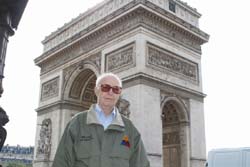 The Arc de Triumph was a destination because Dad remembers it so well from passing thru Paris in Dec, ’44. You reach it via an underground walkway, and once we got there we were surprised to find the tomb of France’s Unknown Soldier with its eternal flame. Every night at 6:30 there is a dignified ceremony to re-kindle the flame, with soldiers, veterans, and dignitaries in attendance to honor the Soldier. The Arc de Triumph was a destination because Dad remembers it so well from passing thru Paris in Dec, ’44. You reach it via an underground walkway, and once we got there we were surprised to find the tomb of France’s Unknown Soldier with its eternal flame. Every night at 6:30 there is a dignified ceremony to re-kindle the flame, with soldiers, veterans, and dignitaries in attendance to honor the Soldier.
The Louvre is another amazing place in which you can spend an entire morning or afternoon if you just want to walk thru it without stopping to check things out, like the
Mona Lisa, the Venus de
Milo, or Winged Victory. Unlike our Smithsonian, it is devoted to art.
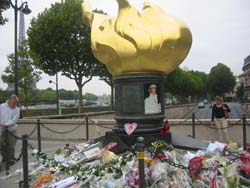 As we wandered around the Seine area, we discovered a full-size replica of the gold flame atop the Statue of Liberty in New York; it was donated to the French people by the American people to mark the 100th anniversary of the gift of the Statue of Liberty by the French to America, which is interesting enough. However, the flame was positioned near a bridge that crosses the Seine, atop a very short underpass – the site of Princess Di’s fatal traffic accident 10 years ago the week we were there. The flame monument has become an unofficial memorial to Diana, with flowers, pictures, sentiments written on the sidewalks, etc. As we wandered around the Seine area, we discovered a full-size replica of the gold flame atop the Statue of Liberty in New York; it was donated to the French people by the American people to mark the 100th anniversary of the gift of the Statue of Liberty by the French to America, which is interesting enough. However, the flame was positioned near a bridge that crosses the Seine, atop a very short underpass – the site of Princess Di’s fatal traffic accident 10 years ago the week we were there. The flame monument has become an unofficial memorial to Diana, with flowers, pictures, sentiments written on the sidewalks, etc.
We’ll be back to Paris.
On Sunday, 2 September, we traveled to Normandy to see the invasion beaches and other sights.
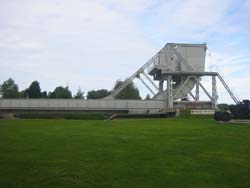 We started at the
Caen museum of war and peace on the east We started at the
Caen museum of war and peace on the east
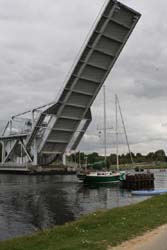 end of the beaches, and traveled thru the city to the ‘Pegasus Bridge’ site. Named after the nick-name of the British 6th Airborne Division, the site was where Brit glider-borne troops landed and seized key bridges over the Orne River and a canal that paralleled it. You may remember the scene from the movie The Longest Day – “Hold until relieved, hold until relieved…” Having accomplished the first mission on D-Day successfully, these troops were relieved later that morning by the bagpiper-led troops of the Royal Marine Commandos.
end of the beaches, and traveled thru the city to the ‘Pegasus Bridge’ site. Named after the nick-name of the British 6th Airborne Division, the site was where Brit glider-borne troops landed and seized key bridges over the Orne River and a canal that paralleled it. You may remember the scene from the movie The Longest Day – “Hold until relieved, hold until relieved…” Having accomplished the first mission on D-Day successfully, these troops were relieved later that morning by the bagpiper-led troops of the Royal Marine Commandos.
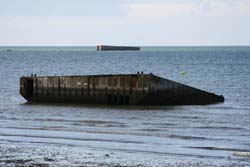 Next we moved west along the coast to Arromanches, a small town at an exit thru the bluffs that overlook the invasion beaches, the site of one of two artificial harbors that were installed to permit the off-loading of the thousands and thousands of tons of supplies and vehicles necessary to support large-scale modern military operations. The harbors, nicknamed “Mulberries,” were made up of old, derelict ships that were sunk to create a breakwater or some relief from the constant waves, and then concrete caissons (called Phoenixes) were floated over from England and sunk in the perimeter created by the old ships. Cargo ships would enter these artificial harbors, tie up to a pier, and offload equipment and vehicles, which would move across pontoon bridges to the beaches. Casualties would be backhauled to England by reversing the flow. All told, the Mulberries were remarkable engineering feats. Next we moved west along the coast to Arromanches, a small town at an exit thru the bluffs that overlook the invasion beaches, the site of one of two artificial harbors that were installed to permit the off-loading of the thousands and thousands of tons of supplies and vehicles necessary to support large-scale modern military operations. The harbors, nicknamed “Mulberries,” were made up of old, derelict ships that were sunk to create a breakwater or some relief from the constant waves, and then concrete caissons (called Phoenixes) were floated over from England and sunk in the perimeter created by the old ships. Cargo ships would enter these artificial harbors, tie up to a pier, and offload equipment and vehicles, which would move across pontoon bridges to the beaches. Casualties would be backhauled to England by reversing the flow. All told, the Mulberries were remarkable engineering feats.
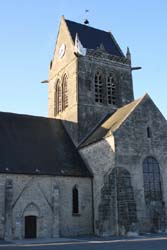 Being old paratroopers, Bob and his son Rob put Ste Mere Eglise and the 82nd Airborne area on the western edge of the invasion zone on the schedule. Ste Mere was captured by the 82d Airborne, and again in The Longest Day, you might remember Red Buttons playing Pvt John Steele, who landed on the roof of the Ste Mere village church and watched the battle unfold below him as he remained suspended from the roof in his parachute harness. Being old paratroopers, Bob and his son Rob put Ste Mere Eglise and the 82nd Airborne area on the western edge of the invasion zone on the schedule. Ste Mere was captured by the 82d Airborne, and again in The Longest Day, you might remember Red Buttons playing Pvt John Steele, who landed on the roof of the Ste Mere village church and watched the battle unfold below him as he remained suspended from the roof in his parachute harness.
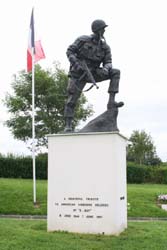 On Monday, 3 September, we began with a side trip to the site of the Airborne memorial just west of Ste Mere, which is where the 82d had its largest action on D-Day and D+1. Today the site is a very small stone bridge (maybe 75 feet On Monday, 3 September, we began with a side trip to the site of the Airborne memorial just west of Ste Mere, which is where the 82d had its largest action on D-Day and D+1. Today the site is a very small stone bridge (maybe 75 feet
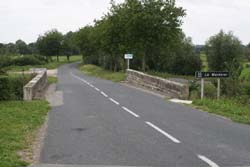 across) over the Merderet River amidst farm fields, but back then it was the only way to move to the east and Utah beach because the Germans had flooded fields throughout Normandy. About ½ of the fighting strength of the 82d was concentrated in this area to block the onward movement of counter-attacking German forces, and a Medal of Honor was posthumously awarded to gliderman Charles DeGlopper, 325th Infantry, for his actions here.
across) over the Merderet River amidst farm fields, but back then it was the only way to move to the east and Utah beach because the Germans had flooded fields throughout Normandy. About ½ of the fighting strength of the 82d was concentrated in this area to block the onward movement of counter-attacking German forces, and a Medal of Honor was posthumously awarded to gliderman Charles DeGlopper, 325th Infantry, for his actions here.
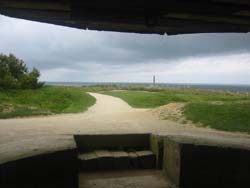 Next we continued east and arrived at Pointe du Hoc, a rocky promontory that separates Utah Beach to the west from Omaha Beach to the east. The supposed site of a battery of large caliber howitzers, troops of the 2nd Ranger Battalion assaulted the position by climbing ropes and assault ladders under fire, only to find that the big guns were gone – moved by the Germans to prevent their destruction by incessant Allied bombing. In fact, the grounds around the point had so many craters that it looked like a golf ball that had been laid out flat. (The guns were subsequently found about a kilometer inland and destroyed by Rangers). The photo is taken from a gun bunker, showing the Ranger memorial atop the cliff. Next we continued east and arrived at Pointe du Hoc, a rocky promontory that separates Utah Beach to the west from Omaha Beach to the east. The supposed site of a battery of large caliber howitzers, troops of the 2nd Ranger Battalion assaulted the position by climbing ropes and assault ladders under fire, only to find that the big guns were gone – moved by the Germans to prevent their destruction by incessant Allied bombing. In fact, the grounds around the point had so many craters that it looked like a golf ball that had been laid out flat. (The guns were subsequently found about a kilometer inland and destroyed by Rangers). The photo is taken from a gun bunker, showing the Ranger memorial atop the cliff.
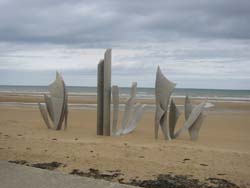 Omaha Beach was next, where the tide was out, extending the beach maybe the length of a football field or
more, the distance 1st and 29th Infantry Division troops had to cross under fire from the German defenders on the heights above. Omaha, perhaps, is the best place to get a sense of how uncertain the outcome of D-Day was to the forces and commanders involved; the landings ran into such opposition that Lt Gen Omar Bradley considered abandoning the effort and diverting subsequent waves of landing craft to Utah Beach. In the end, actions by small groups of infantry and engineers supported by naval gunfire cracked the German line and allowed a breakout. The photo shows a memorial called simply, ‘The Braves.’ To quote an Army historian, “The beach ran red on Omaha Beach…” Omaha Beach was next, where the tide was out, extending the beach maybe the length of a football field or
more, the distance 1st and 29th Infantry Division troops had to cross under fire from the German defenders on the heights above. Omaha, perhaps, is the best place to get a sense of how uncertain the outcome of D-Day was to the forces and commanders involved; the landings ran into such opposition that Lt Gen Omar Bradley considered abandoning the effort and diverting subsequent waves of landing craft to Utah Beach. In the end, actions by small groups of infantry and engineers supported by naval gunfire cracked the German line and allowed a breakout. The photo shows a memorial called simply, ‘The Braves.’ To quote an Army historian, “The beach ran red on Omaha Beach…”
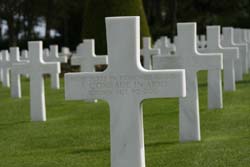 The American Military Cemetery atop Omaha Beach was next, a place known for its beauty and dignity. More than 9,000 soldiers are buried there, victims of the fighting for Normandy and beyond. It contains at least one father-son pair, and several pairs of brothers, to include those from the Niland family, from which Steven Spielburg created the movie, ‘Saving Private Ryan.’
The American Military Cemetery atop Omaha Beach was next, a place known for its beauty and dignity. More than 9,000 soldiers are buried there, victims of the fighting for Normandy and beyond. It contains at least one father-son pair, and several pairs of brothers, to include those from the Niland family, from which Steven Spielburg created the movie, ‘Saving Private Ryan.’
That afternoon we traveled the longest leg of the journey, about a six hour drive to Bastogne, Belgium. In December, 1944, Hitler launched a counterattack to divide the British and American forces and drive to and seize the Dutch port of Antwerp. In what became known as the ‘Battle of the Bulge,’ Allied forces were diverted from other missions to attack the German penetration of their lines – to include the just-landed 11th Armored Division. The 101st Airborne Division had been assigned to secure Bastogne, which had seven roads passing thru it, making it tactically significant – if you control the roads, you can prevent the onward movement of attacking forces, which were under a severe schedule dreamed up by Hitler himself. Sending their infantry streaming around Bastogne, the Germans quickly surrounded the 101st, and relieving them became a top priority for Eisenhower.
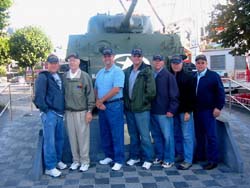 Moving 100 miles north in the dead of winter, the 11th immediately attacked the German flank in and around Bastogne and worked with other units to reduce the German salient. The Sherman tank in the town square was found to be an original vehicle from the 11th Armored, knocked out on 30 Dec. Two men of the five man crew survived the action. The picture shows our Crew in front of that tank wearing hats our sister Mary had made up for us. Moving 100 miles north in the dead of winter, the 11th immediately attacked the German flank in and around Bastogne and worked with other units to reduce the German salient. The Sherman tank in the town square was found to be an original vehicle from the 11th Armored, knocked out on 30 Dec. Two men of the five man crew survived the action. The picture shows our Crew in front of that tank wearing hats our sister Mary had made up for us.
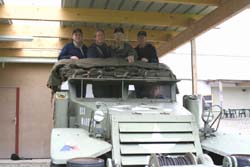 On Tuesday, 4 September, we continued our tour of the Bastogne area, to include a tour of a great little Ma & Pa WWII museum in a crossroads community called Poteau. We were drawn there by the prospect of a tour of part of the battlefield in a re-conditioned American halftrack vehicle, which is what Dad
crossed Europe in; unfortunately the rainy weather and soft soil prevented the tour, so we settled for lots of pix in and around the On Tuesday, 4 September, we continued our tour of the Bastogne area, to include a tour of a great little Ma & Pa WWII museum in a crossroads community called Poteau. We were drawn there by the prospect of a tour of part of the battlefield in a re-conditioned American halftrack vehicle, which is what Dad
crossed Europe in; unfortunately the rainy weather and soft soil prevented the tour, so we settled for lots of pix in and around the
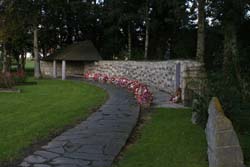 vehicle. On the way back to Bastogne, we stopped at the crossroads village of Malmedy, where on 18 December ‘44, Nazi troops shot dead 82 captured GIs because they were on such a tight time schedule that they couldn’t be hampered by POWs. If memory serves, the commander of the task force that murdered these troops was hung after the war for this and other war crimes. The memorial is a very simple and elegant affair, which lists the names of the GIs on a wall.
vehicle. On the way back to Bastogne, we stopped at the crossroads village of Malmedy, where on 18 December ‘44, Nazi troops shot dead 82 captured GIs because they were on such a tight time schedule that they couldn’t be hampered by POWs. If memory serves, the commander of the task force that murdered these troops was hung after the war for this and other war crimes. The memorial is a very simple and elegant affair, which lists the names of the GIs on a wall.
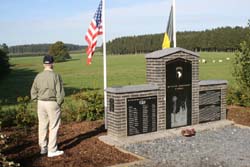 On Wednesday, 5 September, we headed to Luxembourg via the small village of Foy and viewed a small monument to the ‘Band of Brothers’ soldiers of the 101st; if you’ve seen the HBO series, this spot is where Easy Company got repeatedly shelled by the Germans, losing a large number of dead and wounded. On Wednesday, 5 September, we headed to Luxembourg via the small village of Foy and viewed a small monument to the ‘Band of Brothers’ soldiers of the 101st; if you’ve seen the HBO series, this spot is where Easy Company got repeatedly shelled by the Germans, losing a large number of dead and wounded.
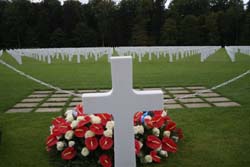 Next stop was the small American Military Cemetery at Hamm, just outside Luxembourg City; the final resting place of about 5,000 GIs, to include General George Patton; his grave faces those of the troops, as if in formation. Ironically, not a mile away is a German Military Cemetery, no less dignified than the American. Next stop was the small American Military Cemetery at Hamm, just outside Luxembourg City; the final resting place of about 5,000 GIs, to include General George Patton; his grave faces those of the troops, as if in formation. Ironically, not a mile away is a German Military Cemetery, no less dignified than the American.
With that, we hit the road for Germany and Rob & Aimee’s quarters on an Army installation in Mannheim, about five minutes from the location where Gen Patton’s vehicle struck a stopped truck in December ‘45, causing injuries that would kill him about a week later.
The next day, Thursday, 6 September, we headed out on the last leg of the TOAL, Austria, where our mission was two-fold; to find the location of a photograph of Dad taken after the war had ended, and to visit the former concentration camp at Mauthausen, which the 11th AD had liberated in May, 1945.
Heading out early on Friday, 7 September, we drove south of Linz to the town of Ebensee at the southern end of Lake Traunsee, which sits between 4-5,000 foot mountains. Dad remembered taking a cable car up to a mountain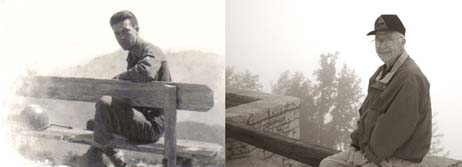 top resort, and sure enough, it is still there, so up we went. Once atop the mountain, we found a ski lodge and almost a foot of snow. Note the picture of Sgt Leicht at left; Dad’s pretty sure it was taken up there. An old postcard we found shows the original layout of the lodge, and sure enough, there’s a bench on the right side of the image. Unfortunately we were in the clouds this day so we couldn’t see the mountains in the background to confirm the precise location, so we took “Then & Now” pictures and chalked it up as a win. top resort, and sure enough, it is still there, so up we went. Once atop the mountain, we found a ski lodge and almost a foot of snow. Note the picture of Sgt Leicht at left; Dad’s pretty sure it was taken up there. An old postcard we found shows the original layout of the lodge, and sure enough, there’s a bench on the right side of the image. Unfortunately we were in the clouds this day so we couldn’t see the mountains in the background to confirm the precise location, so we took “Then & Now” pictures and chalked it up as a win.
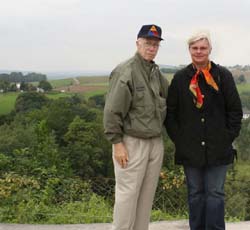 After lunch we met our guide for the tour of the Mauthausen camp, Mrs. Siegi Witzany. Siegi is an English teacher in a local Benedictine secondary school, who became interested in the history of the dozens of camps in the Linz area when she was a teenager; years later, she has become the chair of the Gusen Camp Memorial Committee, whose mission is both education and to honor the memory of victims and liberators. Gusen is a village four kilometers from Mauthausen and the former site of a camp just as big as the headquarters camp at Mauthausen. All the camps supported the German armament industry, to include components of the ME-262, the first operational jet fighter. Production aside, the camps’ other purpose was killing. Siegi was our guide and interpreter through the visitors’ center and then the camp itself, a grim place. The location was selected for a camp because of a marble quarry which had supplied the best quality marble to government buildings in Vienna. The Germans took over the site and starting in 1938 began building the first of about four dozen sites throughout upper Austria. After lunch we met our guide for the tour of the Mauthausen camp, Mrs. Siegi Witzany. Siegi is an English teacher in a local Benedictine secondary school, who became interested in the history of the dozens of camps in the Linz area when she was a teenager; years later, she has become the chair of the Gusen Camp Memorial Committee, whose mission is both education and to honor the memory of victims and liberators. Gusen is a village four kilometers from Mauthausen and the former site of a camp just as big as the headquarters camp at Mauthausen. All the camps supported the German armament industry, to include components of the ME-262, the first operational jet fighter. Production aside, the camps’ other purpose was killing. Siegi was our guide and interpreter through the visitors’ center and then the camp itself, a grim place. The location was selected for a camp because of a marble quarry which had supplied the best quality marble to government buildings in Vienna. The Germans took over the site and starting in 1938 began building the first of about four dozen sites throughout upper Austria.
Still standing are the stone walls and administrative and support buildings, but only a few of the wooden barracks where inmates were housed. A very bad storm within the past year blew down most of the remaining
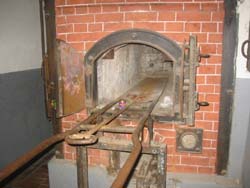 very fragile structures, but the Austrian government will stabilize and maintain the several remaining. Also standing is the building that housed the gas chambers and other killing areas, as well as the crematoria in which the SS disposed of the bodies. We also
very fragile structures, but the Austrian government will stabilize and maintain the several remaining. Also standing is the building that housed the gas chambers and other killing areas, as well as the crematoria in which the SS disposed of the bodies. We also
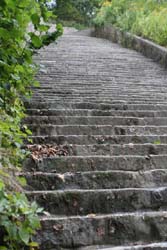 saw the quarry itself, where the SS guards amused themselves by inventing new ways to kill prisoners, to include having emaciated and sick inmates carry stones that sometimes weighed more then the inmates up these stairs, often to their death by exhaustion or accident. If you ever have someone tell you that the industrial-scale murder of people never happened under the Nazis, consider telling he or she to go straight to hell – your father/grandfather/father-in-law/friend is a living witness.
saw the quarry itself, where the SS guards amused themselves by inventing new ways to kill prisoners, to include having emaciated and sick inmates carry stones that sometimes weighed more then the inmates up these stairs, often to their death by exhaustion or accident. If you ever have someone tell you that the industrial-scale murder of people never happened under the Nazis, consider telling he or she to go straight to hell – your father/grandfather/father-in-law/friend is a living witness.
Suffice it to say that it is a grim story and an ugly place – but we were all glad to have seen it, and to have had such an excellent and knowledgeable guide in Siegi
Witzany.
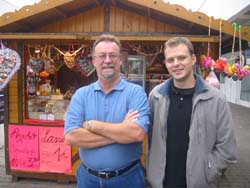 With the TOAL over for the most part, on Saturday, 8 September, we returned to Germany, making one more family connection – Michael Fenton, the son of Russ’s cousin Donald in Manhattan, Kansas. Michael is studying in Berlin and came down to visit with us. We had a very nice end to our visit by taking Rob and Aimee out to dinner in partial thanks for their help in organizing the trip. With the TOAL over for the most part, on Saturday, 8 September, we returned to Germany, making one more family connection – Michael Fenton, the son of Russ’s cousin Donald in Manhattan, Kansas. Michael is studying in Berlin and came down to visit with us. We had a very nice end to our visit by taking Rob and Aimee out to dinner in partial thanks for their help in organizing the trip.
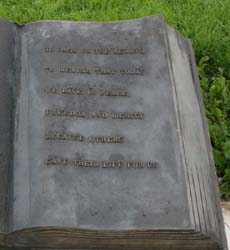 So our adventure ended, with all the stories of ordering wiener schnitzel and cordon bleu because they were the only menu words we could recognize, adjusting to European work hours, and of course, the Euro – traveling across five countries with separate currencies would have been such a pain. Today, European travel is just like moving across our own States, which was a giant help to us on a tight schedule. So our adventure ended, with all the stories of ordering wiener schnitzel and cordon bleu because they were the only menu words we could recognize, adjusting to European work hours, and of course, the Euro – traveling across five countries with separate currencies would have been such a pain. Today, European travel is just like moving across our own States, which was a giant help to us on a tight schedule.
Bright and early on Sunday, 9 September, Rob & Aimee got the Crew to Frankfurt airport for the flight home. All told, it was indeed a Trip of a Lifetime – we visited lots of very cool places, got beaucoup new stories to tell, and most importantly, we honored Dad and his generation for what they did to save the world from evil. |


























